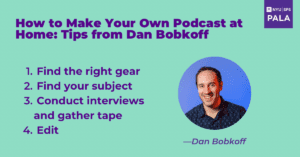Have you ever wanted to make your own podcast? It can seem intimidating, but with the right tools, you could make your own audio project from home! We asked PALA instructor Dan Bobkoff for his expert advice on how beginners can get started. Bobkoff is an experienced podcast producer, having worked with Axios and Business Insider on developing shows. His audio work has also appeared on Marketplace, Planet Money, and 99 Percent Invisible. Bobkoff will be teaching the upcoming Introduction to Podcasting and Radio Reporting workshop from December 1st to 3rd.
Read on below for Bobkoff’s tips for how to get started on your next audio project.
1. Find the right gear that works for you
DB: One great thing about podcasting is its low barrier to entry. You don’t need to spend a ton of money to get started. While I’d never recommend this as your primary setup, if you’re just dabbling, you could get decent audio using an iPhone’s Voice Memos app. But most of us want something a bit more professional. You’ll want to start with a good microphone and recorder. If you never plan to leave your studio, you could buy a USB microphone that plugs directly into your computer. Most sound decent to good. You can improve the sound quality immensely by recording in a room with carpeting, low ceilings, and sound deadening panels on the walls.
If you plan to record out in the field, you’ll want a microphone and recorder. Cardioid microphones will serve you well in most situations. If you find yourself recording often in noisy places (like trying to interview someone in a convention hall), you’ll want to consider a shotgun microphone, which is better at isolating sounds. They’re also good for recording sound that’s far away.
You’ll also need a digital recorder. Thankfully they’ve come down in price in recent years. Look for a recorder with XLR inputs and smooth knob for adjusting recording levels.
Once you’ve recorded your podcast, you’ll need to edit it. I recommend trying Hindenburg editing software. It’ll do most of what you need, works well on older computers, and is cheaper than alternatives. It’s also fairly easy to learn, but the skills will transfer if you eventually move to a more sophisticated program, such as Pro Tools. If you have access to Adobe Creative Cloud, you could also use Adobe Audition.
2. Find your subject
DB: It’s a cliche, but it’s true. Podcasting is perhaps the most intimate medium. Listeners hear shows as voices in their ears, and that can lead to an unmatched connection. That’s why the best podcasts make you feel something. You’ll want to find stories and topics that include emotion and reflection. Find great characters, and “great talkers.” Some people are a joy to listen to; others have trouble communicating in an understandable, conversational way. Take that into account as you book guests. And as you think about what your podcast is about, imagine yourself telling a friend about the story over dinner. How do you sum it up? If your friend’s face lights up after a sentence or two, you’re on the right track.
What doesn’t work well in audio? I’d try to avoid anything complicated involving lots of numbers. Listeners will have a hard time following.
3. Conduct Interviews and gather tape
DB: Most great shows are heavily edited. Many will have dozens of hours of tape for one produced hour. Even interview-style shows typically record longer than what you hear in the finished product.
That said, you’ll want to keep your reporting focused. I recommend pre-interviewing your guests before you do the formal interview. A pre-interview is an informal conversation to get a better sense of the story and to determine if your guest is a “good talker”. You’re taking notes, and trying to find the most interesting aspects of their story. You’re also listening to see if they’ll be clear and engrossing on tape. A pre-interview is a great time to get the basic facts down. But you do not want your guest to have an emotional moment until the real interview. I try to sense where a guest might have emotion, but I won’t push it until there’s a microphone. The worst thing is when a guest says something powerful and it’s not on tape.
Once you get into the formal interview, try to get your interviewee to reflect and tell you how something felt, rather than just what happened.
Because this is audio, you’ll want to avoid talking over your guest. It’s better to nod silently.
And you can do more than just interview someone. Try to capture some “action tape.” If you can hear something happening in the audio, that’s great. Make me feel like I’m in a place with you.
4. Edit
DB: You’ll likely have a lot of material, so it’s time to edit. First you have to decide if you’re going to narrate your podcast or produce it as an interview. If you narrate, you have more control. Narration is great for giving the facts and your sound bites can provide the emotion. In my editing software, I’ll pull a bunch of potential sound bites. And in another window, I’ll start taking notes and writing a bare bones script. For longer pieces, it’s important to outline and keep it focused. You may also want to transcribe your interviews if they’re long. It’ll help you find great material quickly, but you always want to edit using the audio, not the text. Sometimes an edit looks great on the page, but won’t work in the sound.
Interested in learning more? Sign up for the full intensive workshop with Dan Bobkoff, Introduction to Podcasting and Radio Reporting on December 1st to 3rd.
